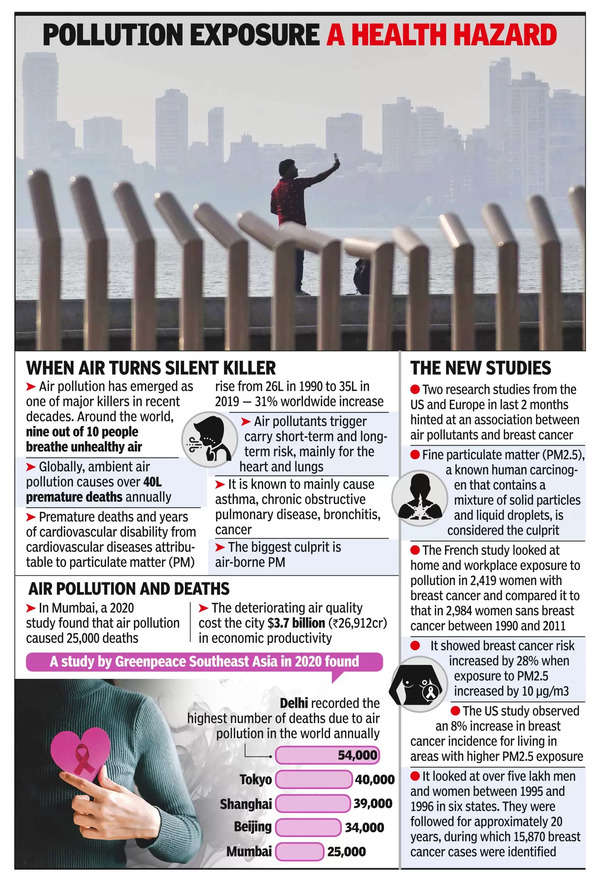[ad_1]
Two international studies – a 20-year study from six states in the US and France – published in the last one month have shown a correlation between indoor and outdoor exposure to particulate matter and breast cancer.
There are multiple studies linking PM2.5 – particles formed in the atmosphere through chemical reactions of gases such as sulfur dioxide, nitrogen oxides, and certain organic compounds – with premature death, particularly in people who have chronic heart or lung diseases, and reduced lung function growth in children. It was only in 2015 that the International Agency for Research on Cancer concluded that PM in outdoor air pollution causes lung cancer.

In Mumbai, it was for long believed the sea breeze protects its citizens from air pollutants, but the PM levels in the last couple of years have shown otherwise. A week back, the levels of PM10 were higher in Mumbai than Delhi, among the most polluted cities in the world. Faiyaz Shaikh of Govandi New Sangam Welfare Society knows the harms of air pollution too well. “We used the RTI Act to find out that nine out of every 100 patients with asthma are from Govandi, which is close to the Deonar dumpyard. We have the highest incidence of respiratory ailments like TB, bronchitis and COPD,” said Shaikh, who fought a long legal battle to relocate a polluting incinerator to an industrial area.
City Doctors Sceptical
The PM2.5-breast cancer link is too new, with barely a handful of studies from the West suggesting a correlation. Medical oncologist Dr Uma Dangi from Fortis Hospital, Mulund, said air pollutants trigger an inflammatory response in the body that could be the reason for the increased cancer risk. “It is essential to identify risk factors so that they can be modified to reduce the risk,” she added.
However, breast cancer surgeon Dr Vani Parmar is sceptical. “A correlation doesn’t mean air pollutants are the cause of breast cancer,” she said, adding it is advisable to wait for more in-depth studies before making a direct link. “Unlike other cancers, breast cancer isn’t linked to any pathogens or carcinogens except for smoking. It’s mainly due to hormone-influenced factors,” said Dr Parmar, who heads the breast cancer department at the Head & Neck Cancer Institute of India, Mazgaon.
The Foreign Studies
The French study, which was presented at the European Society for Medical Oncology (ESMO) Congress 2023 held in Madrid, found that breast cancer risk increased by 28% when exposure to fine particle (PM2.5) air pollution increased by 10 g/m3. It studied 2,419 women with breast cancer and another 2,984 women without breast cancer between 1990 and 2011.
The US study, which was published in the Journal of the National Cancer Institute in early September, found an 8% increase in breast cancer incidence among those living in areas with higher PM2.5 exposure. The study followed five lakh women and men over a 20-year period and found 15,870 breast cancer cases.
Speaking at the ESMO meeting, oncologist Charles Swanton from London said PM2.5 could penetrate deep into the lung and get into the bloodstream from where they are absorbed into breast and other tissues. Stating there is evidence that air pollutants can change the architecture of the breast, he said tests should be done to see if these microscopic pollutants “allow cells in breast tissue with pre-existing mutations” to expand and cause tumours.
Breast Cancer A Big Scare
In India, the incidence of breast cancer increased by 50% between 1965 and 1985. As per the Globocan data 2020, in India, breast cancer accounted for 13.5% (1,78,361) of all cancer cases and 10.6% (90,408) of all deaths. Studies estimate the global burden of breast cancer is expected to cross almost 20 lakh by the year 2030. “We have been through hair colours and deos being blamed for breast cancer, but they were proved to be wrong. Instead of blaming air pollutants, we should promote awareness so that breast cancer is diagnosed early when treatment has best results,” said Dr Parmar.
[ad_2]
Source link





Join The Discussion